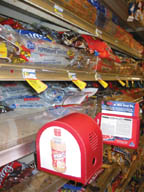
ScentAir Technologies, a Santa Barbara, Calif.-based technology company, has provided wide-area scent-enhancement systems to retailers such as BI-LO grocers and the Hershey's store in New York's Times Square. Recently, the firm devised a smaller, less expensive device for use with product-specific promotions. "It's like product sampling, but instead of costing $400 to $500 per 1,000 samples, it can be delivered for $10 to $20," according to CEO Forrest Fleming. Pilots for Kraft Foods' Post Banana Nut Crunch cereal and General Mills' Pillsbury Cookie Dough were executed in the fall, and Fleming expects major promotions to break in the coming months. Remy Amerique is using the technology to launch Mount Gay flavored rums, with vanilla or mango aromas wafting around liquor displays.
A simple electromechanical element delivers the scent. A motion detector activates a fan, which blows ambient air across a cartridge's surface that has been impregnated with the desired fragrance. Olfactory molecules measured in parts per billion are emitted, eliminating the problem of excessive scenting and possible staining that occurs with an atomized spray. "It gives the scent in a subtle way, without any residue," says Fleming.
David A. Martin developed the technology while at Lockheed for use with virtual reality games. He later devised precision dispensers with multiple fragrances for Disney to use in movie theaters where odors could be coordinated with visuals. While smell-o-vision has yet to materialize on a commercial basis, the creation of high quality, well controlled scents "has unbelievable potential," Fleming believes. "It's never been done with clean and controllable scent before." The scent cartridge lasts up to four weeks. Devising fixtures to meet the demands of individual food marketers has been the biggest obstacle to implementation, he says.
For more information:
Forrest Fleming, ScentAir Technologies, 805-964-2424

Shuttle car system finds an audience
If customer specifications never changed, mechanical systems would work just fine in packaging departments. Unfortunately, customer requirements are becoming more customized, and that is creating demand for robotics that adapt with programming changes instead of hacksaws and welding."Packaging requirements are changing more frequently," suggests Paul Burdick, an executive with Schneider Packaging Equipment in Brewerton, N.Y. "A robot is much more flexible than a conveyor and doesn't require cut-metal change." That's generating demand for his shuttle car system for automated pallet transfer at the ends of packaging lines.
After a pallet is built, it either is conveyed or forklifted to a stretchwrapper or into a storage area, Burdick notes. Building conveyors for multiple palletizers is expensive, and forklifts are labor intensive. A more inexpensive and adaptable solution is a shuttle car, particularly one that can be integrated into the distributed controls structure of a plant. "The more lines you're handling, the more economical it becomes," he says, and Schneider has installed systems that handle up to four palletizers. At least two lines are necessary to make the system practical.
Completed pallets are conveyed to the shuttle's platform, which accepts slipsheets as well as wooden skids. A 0.75 HP motor with a variable frequency drive powers the loaded shuttle along a guide rail at a right angle to the conveyor, transferring the load up to 100 meters. Flat metal rails provide an even surface for the shuttle's 6 in. urethane wheels, and controls wiring and power cables are housed between the guide rail and one of the flat rails. Speeds up to 40 ft. per minute are typical, though the unit can travel up to three times faster under ideal conditions, Burdick says.
For more information:
Paul Burdick, Schneider Packaging Equipment, 315-676-3035

Goof proof turkeys debut in fall
A long-term development project moves from the lab to the packaging line at Hormel Foods' Jennie-O production facilities this month as the company starts building inventory for the Thanksgiving turkey sales season.A special cooking bag that retains juices and delivers even heating, even if the turkey is frozen, has been developed for the brand's new Oven Ready line. The bag's composition is a closely guarded secret for now-group product manager Steve Venenga says Jennie-O doesn't want competitors to get a fix on the system before the holiday season arrives-but the packaging should command a premium price and overcome consumer trepidations about turkey preparation.
Venenga expects retailers to price Oven Ready turkeys at about $2 a lb, markedly higher than the 69 cents to $1.39 that frozen birds typically command at Thanksgiving. "The alternative isn't other frozen turkey but precooked ones, which are $5 a lb.," he says.
The birds come with a specially designed pop-up timer, he adds, and the hocks are not tied together, unlike conventionally packaged turkeys. Necks and giblets also are absent, and a basting solution that adds up to 10 percent to the net weight is included. An unseasoned "home style" baste and a butter, garlic & herb solution will be offered, and consumer can opt for a half-turkey with white and dark meat.
The outer bag is polyvinyl chloride and includes a built-in handle and an easy-open zip strip on the side.
Focus group research suggested consumers dislike handling raw meat, Venenga says. The cooking bag eliminates the need to wash the uncooked bird, and neck and giblets " are trending down as a part of the meal."
